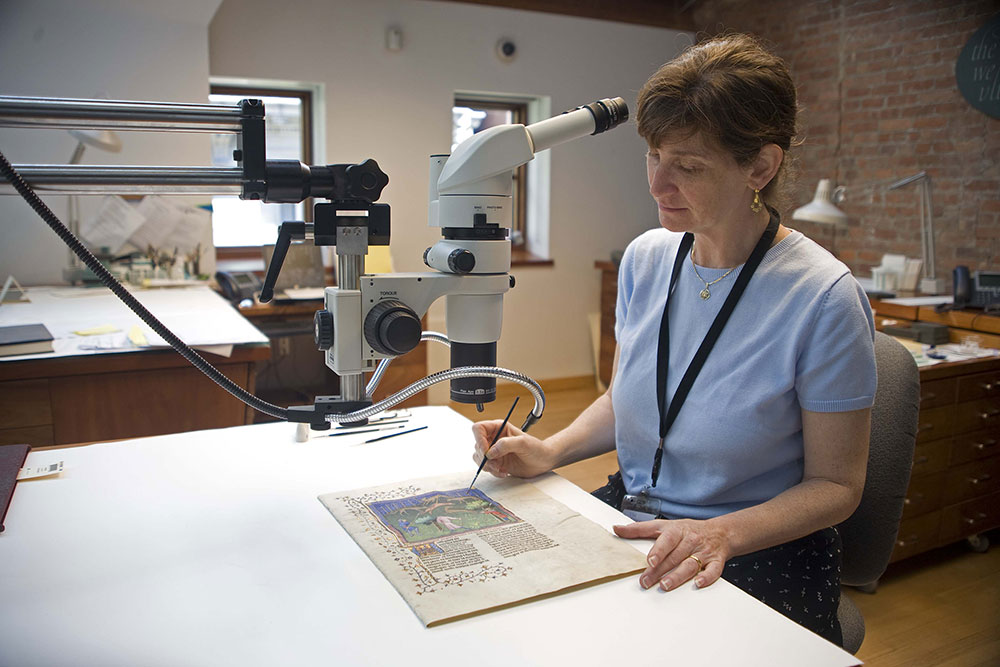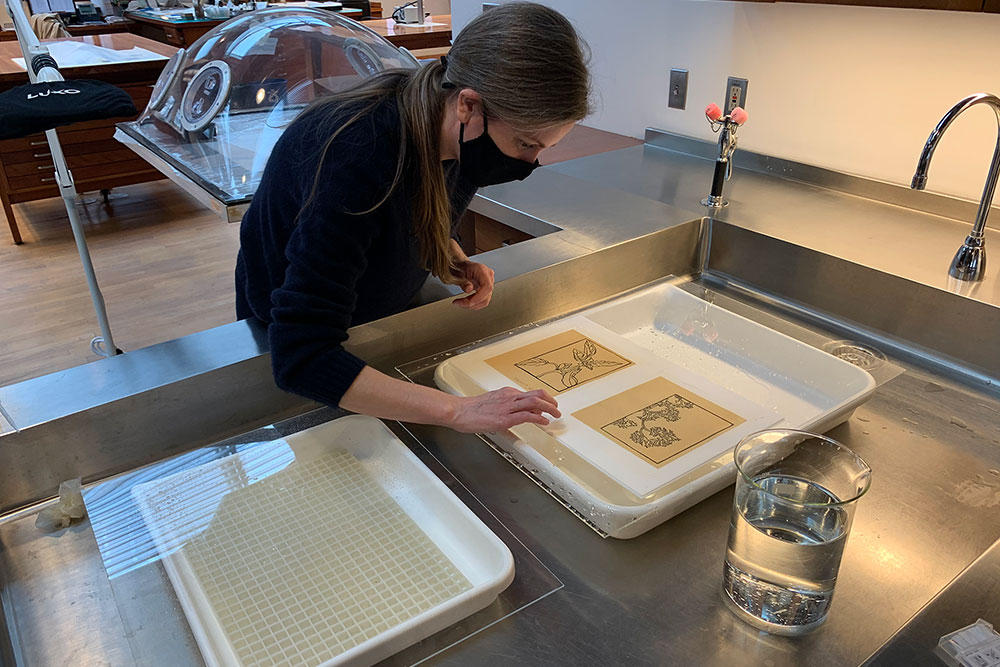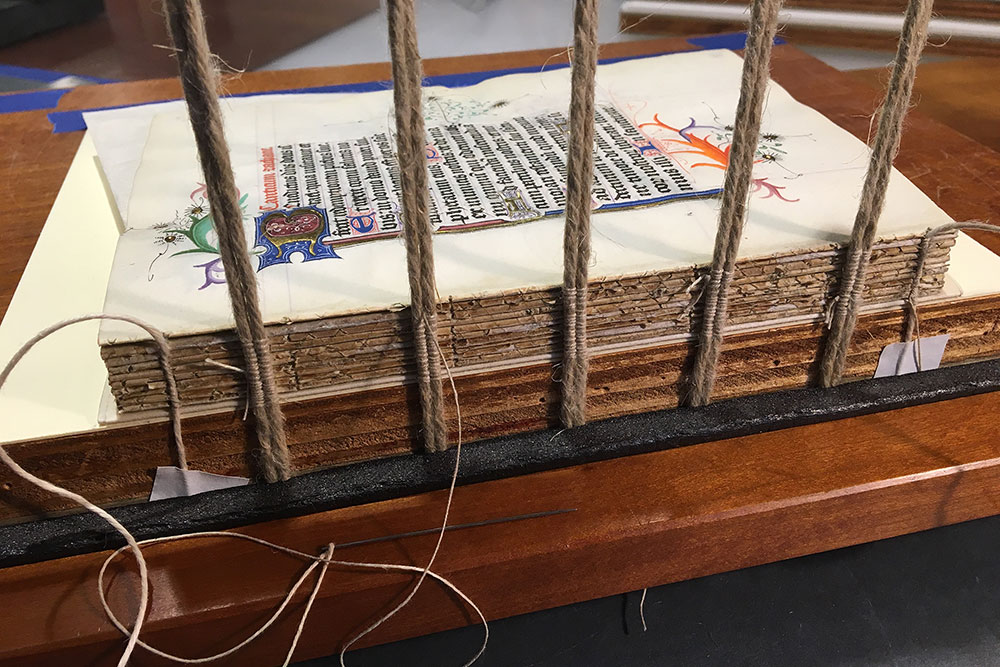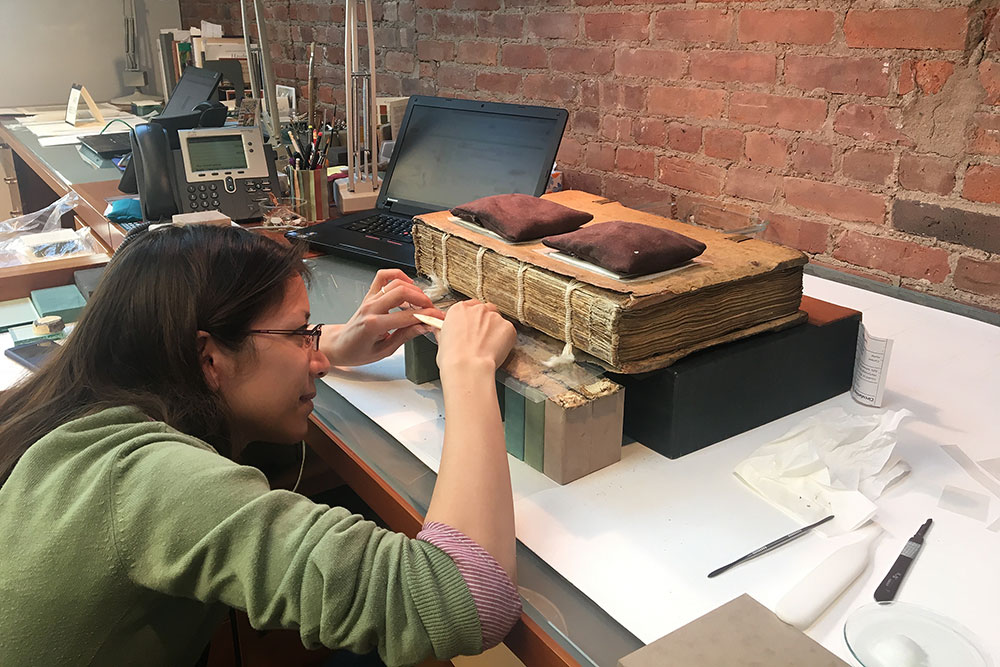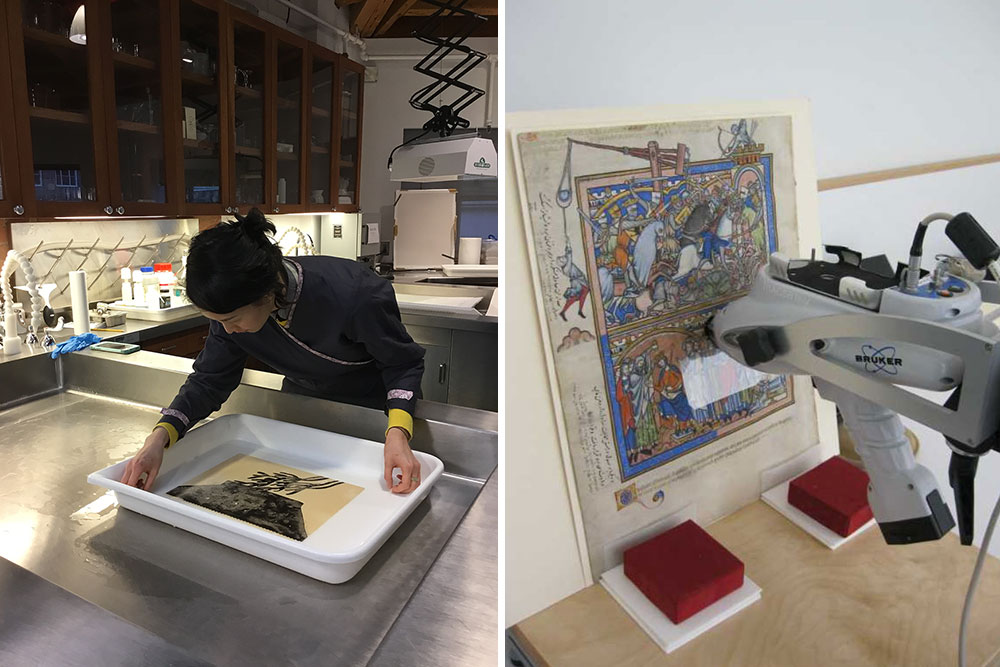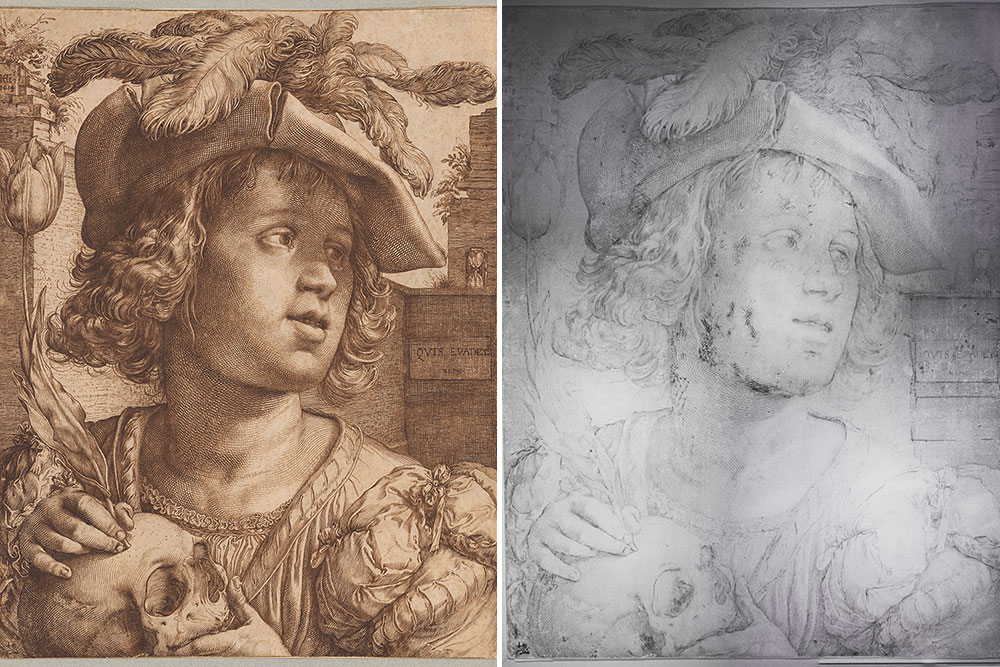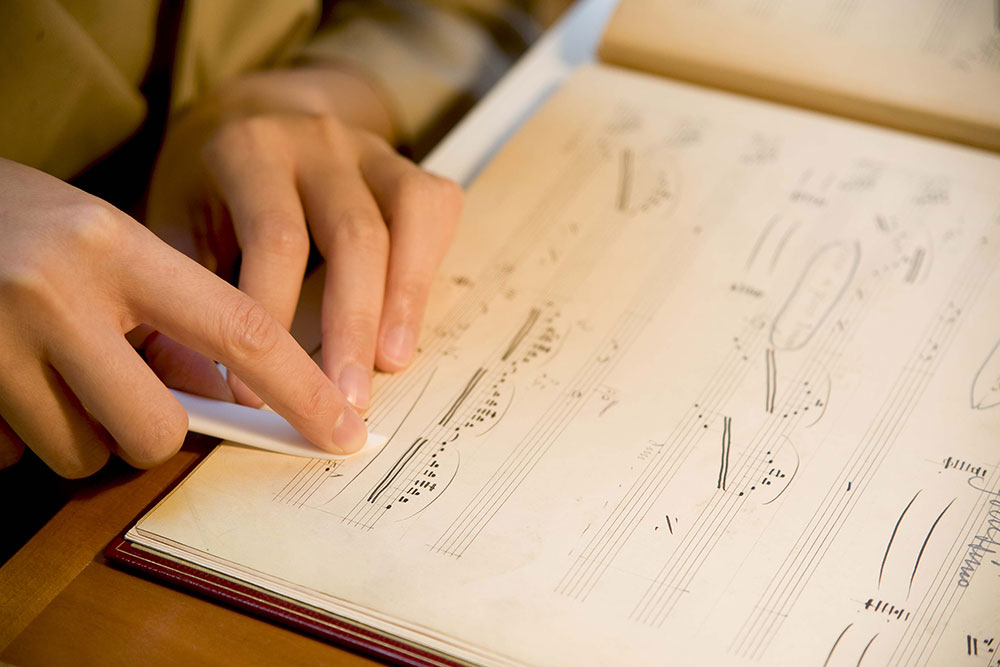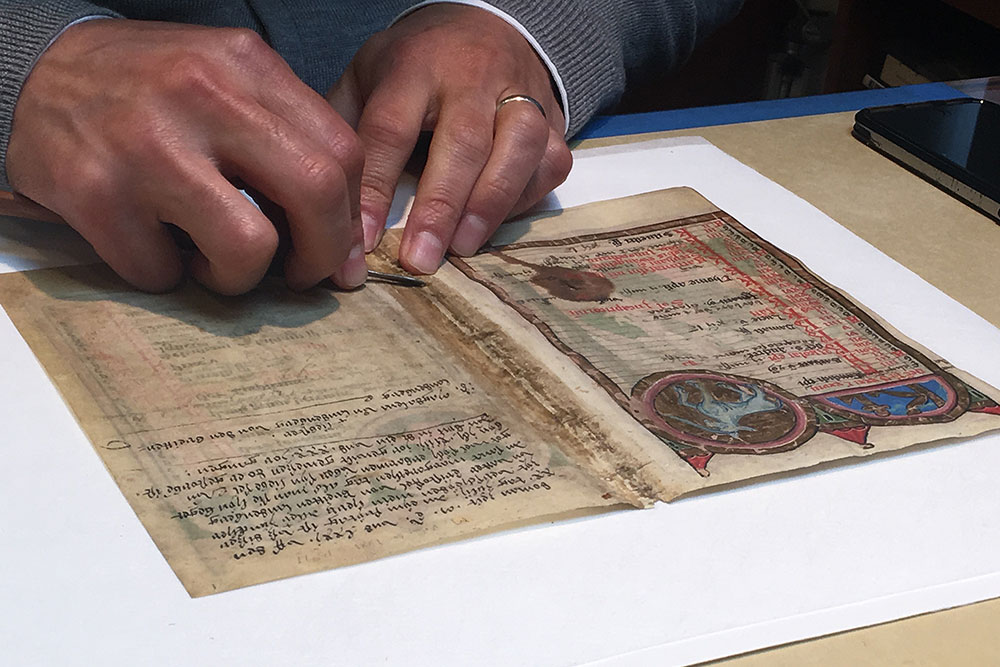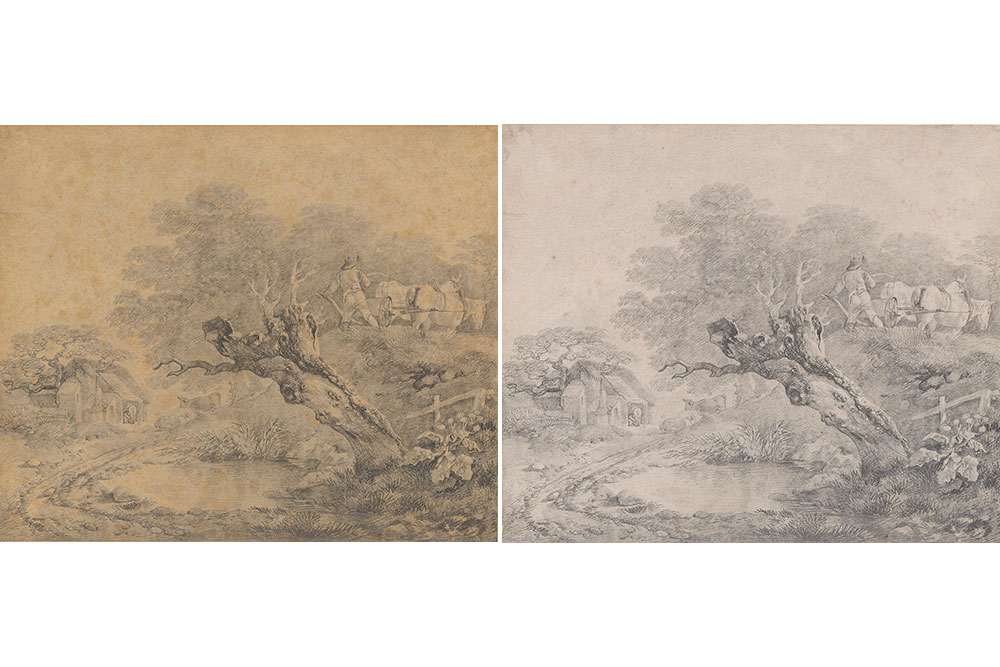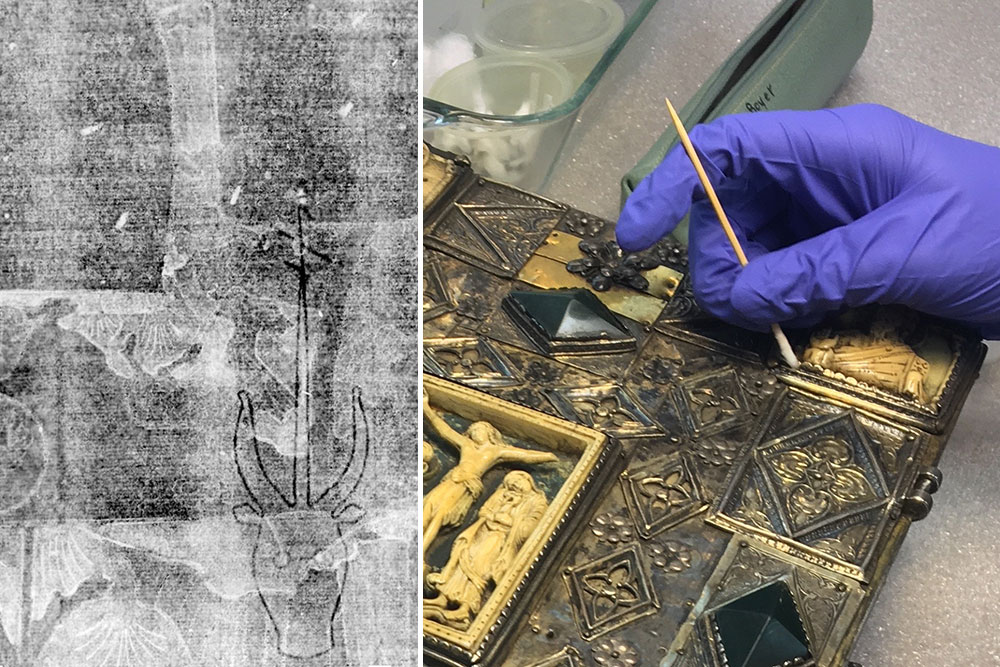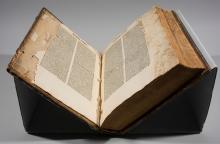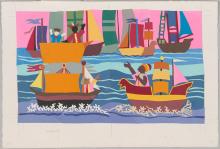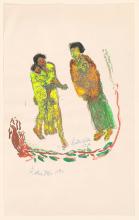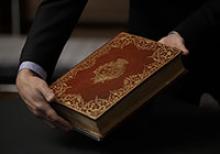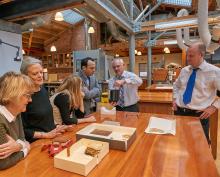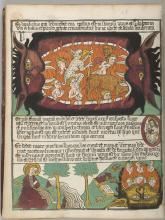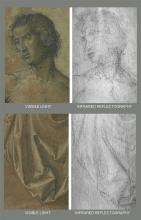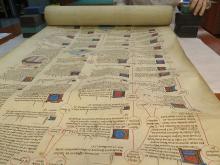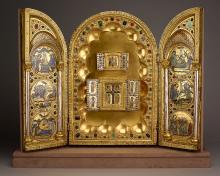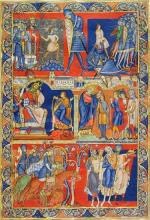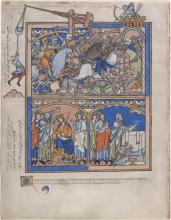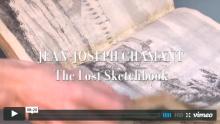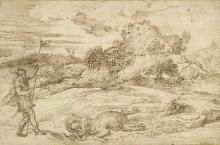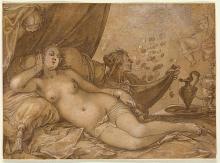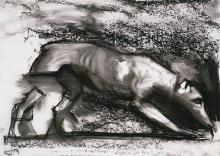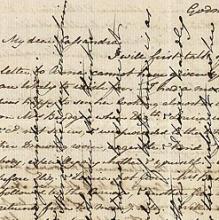The Thaw Conservation Center at The Morgan Library & Museum is a world-class laboratory for the conservation and technical study of the Morgan’s core holdings: drawings, prints, photographs, illuminated manuscripts, printed books, bookbindings, and literary, historical, and music manuscripts. The work of the Thaw Center is essential to the Morgan’s institutional mission, helping to preserve, document, interpret, and make accessible our extraordinary and varied collections. The Thaw Center’s activities encompass conservation treatment as well as a number of preventive conservation measures, such as environmental monitoring and protective housing of collections. Research and technical studies often involve collaboration with curators, museum scientists, imaging specialists, and conservators in allied specialties. Research results are shared in lectures, publications, and posts on the Morgan’s blog and social media platforms.
The Morgan has had a long-standing commitment to the conservation and preservation of its collections, with both book and paper conservators working on site as early as the 1950’s. The design and construction of the Thaw Center, which was completed in 2002 with support from Eugene V. and Clare Eddy Thaw, transformed the conservation program by creating a unified, state-of-the-art facility where book and paper conservators work together in spacious, purpose-built surroundings. Now occupying 5,600 square feet on the fourth floor of the historic Morgan House, the Thaw Center includes designated spaces and equipment for paper conservation, book conservation, matting and framing, exhibition preparation, collection rehousing, and specialized examination and imaging techniques. A seminar room and departmental reference library supports the Thaw Center’s education and outreach programs, which include lectures, classes, and workshops for students, educators, conservation professionals and members of the public.
The Thaw Center is currently staffed by two book conservators, two paper conservators, one full-time preparator and two part-time conservation technicians. Generous funding from the Sherman Fairchild and Pine Tree Foundations has provided ongoing support for two post-graduate fellowships in book and paper conservation.
Plan your visit. 225 Madison Avenue at 36th Street, New York, NY 10016.
Plan your visit. 225 Madison Avenue at 36th Street, New York, NY 10016.
Thaw Conservation Center
More from the Thaw Conservation Center
The Hidden Layers of the Codex Lippomano: A Study of the Earliest Plaquette Binding
Submitted by Thaw Conservati... on Mon, 09/16/2024 - 11:00amIn late 2023, the Morgan Library & Museum acquired Codex Lippomano (PML 199044) from the Sotheby’s auction of the T. Kimball Brooker collection. This manuscript is the earliest known example of a plaquette binding from the Italian Renaissance, integrating Classical antiquity and Islamic decorative styles within an Italian structure.
A Letter From Helen Keller
Submitted by Thaw Conservati... on Thu, 05/16/2024 - 10:57amThe Morgan holds in its collection two letters handwritten by Helen Keller in 1890, one of which is currently on view in the East Room of J. Pierpont Morgan’s Library. Keller’s lifetime of accomplishments, despite having lost her sight, hearing and speech at a very young age, are already familiar to most people. Yet this letter, written when she was only ten years old, provides extraordinary material evidence of her determination to overcome barriers to communication and engage with the outside world.
Distrust in the Strength of Paper, Part II
Submitted by Thaw Conservati... on Tue, 12/05/2023 - 11:42amIn Part I, I discussed how bookbinders in the fifteenth century did not have full confidence in the strength of paper for text blocks in books, and how parchment lingered in bookbinding practice to reinforce the paper gatherings.
Distrust in the Strength of Paper, Part I
Submitted by Thaw Conservati... on Mon, 11/27/2023 - 1:00pmIn the history of European bookbinding, the transition from parchment to paper as the primary material for text leaves caused an associated shift in bookbinding practices, as bookbinders adapted to what they thought of as a weaker material. Parchment is made of animal skin, prepared by dehairing, stretching, scraping, and drying, whereas paper at the time was made of plant-based materials, such as cotton and flax.
An Invitation to Peep: Paper Peepshows from the Eighteenth- to Twentieth-Century Western World at the Morgan
Submitted by Thaw Conservati... on Fri, 09/08/2023 - 1:00pmColor and Texture: An exploration of Ashley Bryan's collage papers
Submitted by Thaw Conservati... on Fri, 01/13/2023 - 10:55amThis is a guest post by Lindsey Tyne, Conservation Librarian, NYU Libraries
Ashley Bryan (1923–2022) used colored and hand-painted papers cut into the shapes of people, ships, water, land, and sky to create the collages that fill the pages of Sail Away, 2015, as printed images. When these eighteen collages (2021.25:1–18) entered the collection of the Morgan Library & Museum in 2021 as a gift of the Ashley Bryan Center, I was drawn to the rich colors and textures of the collage papers and immediately recognized one paper, Canson Mi-Teintes®, by its distinctive honeycomb texture.
It's Shiny! It's Sparkly! It's Glitter!
Submitted by Thaw Conservati... on Fri, 10/22/2021 - 2:00pmThis post was created by Lindsey Tyne, Associate Paper Conservator
The gold, silver, red, and blue flakes that give Standing Together, 1986 (2018.105) by Luster Willis (1913–1990) its seductive sparkle are commonly known as glitter. Many of us instinctively know what glitter looks like and may even recall a childhood craft project or a greeting card we recently received, despite the fact that how glitter is made and what it is made of are trade secrets.
Bound for Versailles: Investigating the Jayne Wrightsman Bookbindings Collection
Submitted by Thaw Conservati... on Wed, 06/23/2021 - 2:54pmIn anticipation of the upcoming exhibition Bound for Versailles: The Jayne Wrightsman Bookbindings Collection, on view June 25 through September 26, 2021, our conservators from the Thaw Conservation Center took a close look at techniques used in creating these elaborate works of art.
Corners and Edges: The Physical Evidence of Édouard Vuillard’s Sketchbooks
Submitted by Thaw Conservati... on Mon, 04/05/2021 - 10:12pmSeveral of the drawings included in Édouard Vuillard: Sketches and Studies come from sketchbooks spanning the artist’s entire career with dates as early as the 1890s to the 1930s. This exhibition provides the unique opportunity to learn about Vuillard’s preferred sketching materials. While preparing the drawings for installation, I looked for connections between them, with particular attention to similarities and differences in the physical evidence.
Inside Story: Using X-ray Microtomography to See Hidden Features of a Manuscript Codex
Submitted by Thaw Conservati... on Sun, 11/01/2020 - 12:43amTaming the Wild Things: Storage Considerations for the Bequest of Maurice Sendak
Submitted by Thaw Conservati... on Thu, 09/24/2020 - 2:30pmOver 900 objects relating to Maurice Sendak’s (1928–2012) stage designs for The Magic Flute, The Cunning Little Vixen, Love for Three Oranges, The Nutcracker, and an opera based on Where the Wild Things Are arrived at the Morgan in 2013 as part of the artist’s extraordinary bequest. For many of us, the magic of Sendak’s books, in particular Where the Wild Things Are, live vividly in the memories of our childhood. It is thus both a delight and an honor to create a safe home for these wonderful objects.
Color and Curious Creatures: Fifteenth-Century Block Books at the Morgan, Part II
Submitted by Thaw Conservati... on Fri, 08/21/2020 - 11:52pmAn earlier post discussed some of the traditional colors that appear in the Morgan’s block books. In most cases, the hand-applied colors are typical of the dyes and pigments seen in the Middle Ages and Renaissance. However, a few unexpected pigments were discovered during the study of these fifteenth-century books, enabling a better understanding of how some of them were changed over the centuries.
Color and Curious Creatures: Fifteenth-Century Block Books at the Morgan
Submitted by Thaw Conservati... on Wed, 07/08/2020 - 7:00pmHol(e)y Moly!: Historical Damage and Repairs in Medieval Manuscripts
Submitted by Thaw Conservati... on Thu, 07/02/2020 - 6:00pmWhen looking at a medieval manuscript, it is often the illuminations that catch the eye—colorful figures rendered in miniature, gleaming gold backgrounds, ornate initials that twirl and bloom across the margins. But beyond the illuminations, and even beyond the text, the substrate itself merits closer inspection.
Materials and Decorative Techniques of the Read Album Leaves
Submitted by Thaw Conservati... on Fri, 05/15/2020 - 12:00amThe Morgan Library & Museum holds a collection of fifty-seven Persian and Indian album leaves acquired by J. Pierpont Morgan from Charles Hercules Read in 1911. These leaves are collectively known as the Read Albums and are broadly divided into two groups, Persian (MS M.386.1–.21) and Indian (MS M.458.1–.36).
Looking at Works of Art on Paper: An Overview of Examination and Imaging Techniques
Submitted by Thaw Conservati... on Fri, 05/01/2020 - 12:00amConservators in the Thaw Conservation Center (TCC) often spend time just looking at objects in the Morgan’s collection with the goal of understanding the physical structure of the object, the materials that make up the object, the support the object is made on, the techniques used to make the object, the object’s current condition, and even how the object may have looked at the time of its creation.
Preserving and Revealing the Museum’s Treasures
Submitted by Thaw Conservati... on Mon, 11/13/2017 - 11:19amThe Thaw Conservation Center at the Morgan is a world-class laboratory for the conservation of works on paper and parchment—drawings, prints, photographs, illuminated manuscripts, rare books, fine bindings, and literary, historical, and music manuscripts—as well as a place for conservation studies.
Conservation treatment of Haydn's The Seven Last Words of Our Savior on The Cross (Cary 508)
Submitted by Thaw Conservati... on Mon, 07/17/2017 - 12:16pmIn 1786, the Clergy of the Cadiz cathedral in Spain commissioned Joseph Haydn (1732–1809) to compose The Seven Last Words of our Saviour on the Cross. In 1791, a copyist’s manuscript of the full orchestral score, with annotations by Haydn himself was prepared for a series of concerts to be held in London.
Behind the Scenes: Conservation on the Stavelot Triptych
Submitted by Communications ... on Thu, 04/13/2017 - 11:07amIt's extra bright in Gilbert Court now that the Morgan's extraordinary Stavelot Triptych is back on display.
The splendid twelfth-century object (from the Abbey of Stavelot in Belgium) was originally intended to hold relic fragments of the True Cross.
Conference Presentations
Submitted by Thaw Conservati... on Tue, 06/14/2016 - 9:28pmConservators working in the Thaw Conservation Center at the Morgan Library & Museum undertake technical research projects relating to the objects they are treating for the Morgan's robust exhibition and loan program, for digitization, and for scholarly access in the Reading Room.
Technical Analysis of The Crusader Bible
Submitted by Thaw Conservati... on Fri, 11/21/2014 - 1:48pmTo enhance our understanding of the Crusader Bible, the Thaw Conservation Center performed non-destructive analysis including X-ray fluorescence spectrometry and digital imaging techniques to characterize the pigments in folios believed to be executed by different illuminators.
Jean-Joseph Chamant: The Lost Sketchbook
Submitted by Thaw Conservati... on Thu, 06/19/2014 - 11:59amTake a peek inside a rare and fascinating 18th-century artist's sketchbook of theater designs, recently discovered at NYU's Villa La Pietra, in Florence, Italy.
Titian's Heroes: A Forensic Analysis Detail of Titian drawing under normal light
Submitted by Thaw Conservati... on Tue, 05/13/2014 - 4:25pmConservators in the Thaw Conservation Center partnered with international colleagues to analyze these two sixteenth-century Venetian works using imaging techniques much like those employed by forensic investigators.
From Drawing to Print: Abraham Bloemaert's Danaë Receiving the Golden Rain
Submitted by Thaw Conservati... on Fri, 01/20/2012 - 4:26pmUntil the nineteenth century it was common for works of art to be disseminated in the form of prints. But how was an artist's work transferred from paper to printing plate? In this post, we take a close look at a seventeenth-century drawing by the Dutch painter, draftsman, and printmaker Abraham Bloemaert (1564–1651) and the engraving derived from it.
Edgar Degas
Submitted by Thaw Conservati... on Sat, 09/24/2011 - 11:44amIn the early 1890s, when Degas' work became increasingly less naturalistic, he produced a series of pure landscapes that freely interpret the scenery he encountered on his way to visit the painter and printmaker Pierre-Georges Jeanniot in the village of Diénay, near Dijon. There Degas produced about fifty monotypes, which he enhanced with vivid pastel work.
Preserving the manuscript
Submitted by Thaw Conservati... on Fri, 09/23/2011 - 5:56pmIn 2011 the manuscript of A Christmas Carol received extensive treatment by conservators at the Morgan's Thaw Conservation Center.
Ingres at the Morgan: Materials and Methods
Submitted by Thaw Conservati... on Fri, 09/09/2011 - 10:02amWhether he was making portraits of family and friends or preliminary studies for important history paintings, Jean-Auguste-Dominique Ingres (1780–1867) created drawings of great subtlety and nuance. Close examination of the paper and media allows us to glimpse the working methods of one of the greatest draftsmen and portraitists in French history.
Jim Dine: Drawing with Light
Submitted by Thaw Conservati... on Wed, 05/11/2011 - 9:47amJim Dine was inspired by a 1984 trip to The Glyptothek in Munich, to create a series of figurative drawings based on Greek and Roman antiquities; they would ultimately function as positive transparencies in the production of the heliogravure prints (helio — "light"; gravure — "engraving") for his limited edition book Glyptotek, 1988.
Dürer and the Woodcut
Submitted by Thaw Conservati... on Fri, 05/14/2010 - 8:25amThe woodcut, one of the earliest printmaking techniques, became popular in Europe around 1400. Woodcuts are produced by carving an image into a block of wood, usually a hard fruitwood, cut parallel to its grain. Only the lines and shapes of the drawn design are left standing in relief; all other areas of the wood are carefully excised with sharp woodworking tools, such as gouges, chisels, and knives.
Jane Austen's Writing: A Technical Perspective
Submitted by Thaw Conservati... on Fri, 11/06/2009 - 1:57pmWhile it is conjectured that Jane Austen wrote over 3,000 letters, only 160 have survived. Of these, the Morgan owns fifty-one—more than any other institution in the world.

